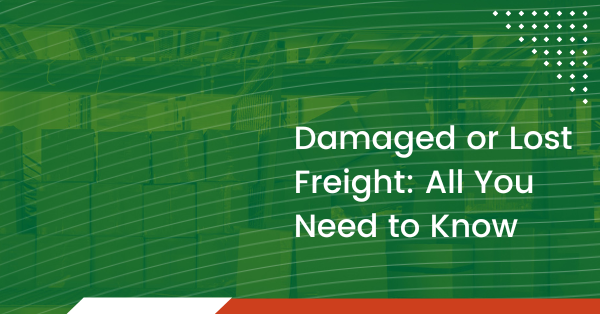What is damaged freight?
Whether someone orders shoes online or ships tons of industrial equipment, one common problem can happen: the freight can become lost or damaged. As these different shipments travel across the world, they inevitably face the risk of damage or loss along the way. A package that travels on a long route has an increased chance of getting damaged or lost. Carriers and manufacturers do whatever they can to reduce the possibility of damaged or lost parcels, but sometimes it’s difficult to avoid because of human error.
Determining who is responsible for damaged freight could take months, and discovering whether cargo had been stolen or lost can be difficult. Shippers will never be able to prevent all instances of lost or stolen cargo, but they can at least ensure receiving compensation for their loss and getting information on the details to try and prevent future instances.
What is the most crucial rule for receiving freight? Do not sign the Bill of Lading before checking your load for damage, concealed damage, or missing parts.
What are the types of damaged freight?
There are four types of freight damage: visible, shortage, concealed, and loss. Visible damage is when you can see that the package is visibly damaged. The shortage is when you only receive one part of the shipment. Concealed damage occurs after the driver has left, the consignment is unpalletized, or the boxes are unopened. Lastly, loss means that the package never reached its destination.
Handling damaged freight
Let’s walk through this step-by-step to determine the proper course of action when something goes wrong with your freight. Life is not perfect – all of us know that. Accidents may happen during your shipments, and when those accidents happen, you should know the proper steps to take whenever your freight may get lost or damaged during transit or when it’s delivered.
1. Inspect your freight
Take a close look at the delivered freight and inspect all the details. Pay attention to every part or item; open crates if needed – there could be concealed damage. Determine what got stolen, missing, or damaged. Don’t be intimidated by the driver, who can claim they are in a hurry for the following route – you have a right to record all details necessary.
2. Communicate with your carrier or broker
Contact your shipping company. There is a slight chance that your cargo is delayed instead of wholly lost. Unfortunately, delays in transportation can occur for many different reasons. The logistics provider is the first facility you should contact. If you are working with a third-party logistics service (3PL), they will reach out to the carrier for you and help solve many additional issues.
3. Document the damage
Write everything down and take photos, if possible. The more documentation you have, the better. Make notes of the damages and shortages on the Bill of Lading and ensure the carrier is aware of the situation as soon as possible. Don’t underestimate the importance of communication and cooperation. Carriers can try to salvage, re-deliver, or return the freight if the damage or shortage statement gets passed on too quickly.
4. Never say no
Do not refuse a shipment and never discard damaged freight. If shippers get rid of the cargo, they may not receive payment for the total freight claim amount. So, keep all loads and packages intact if possible.
5. Complete your claims paperwork
Fill out the proper freight claim, shipping claim, cargo claim, or transportation claim paperwork. It is a legal request to a carrier for financial reimbursement on damaged or lost freight. The freight claim recovers costs for the shipper but not the profit–the difference between the original value and the damaged value. So, the shipper must determine a reasonable dollar amount for the claim – it is the shipper’s legal obligation to minimize the cost of the claim.
The carrier must acknowledge a claim within 30 days of initial filling. Concealed damages and shortages report to the carrier within 10-15 days of receipt of the load.
6. Make sure to pay your bill
Pay the freight bill as soon as possible. The shipper is still responsible for paying for goods’ transportation, even if damaged, lost, or stolen freight. An insurance claim will process the claim.
Keep all necessary documents:
- A copy of the bill of lading
- A copy of the freight bill (paid)
- A copy of the invoice showing the amount paid for the goods
- A copy of the packing slip
- A standard claim form or a letter identifying the shipment and the claim amount
- Photos of the damage
While getting compensation for damaged or lost freight seems fair, it is more important to gather as much information and evidence as possible to avoid further improper load handling. Having an expert who can manage all of a shipper’s claims and paperwork is a great option to save money, time, and peace of mind.
Freight insurance
The most important step you can take to protect your cargo and budget is freight insurance. Freight insurance is a safeguard that ensures the protection of all or some of your cargo. Many 3PLs, including PLS Logistics Services, offer freight insurance as an optional step in your booking process. If something does happen to your freight, the insurer will reimburse its value, so your business doesn’t pay the cost. Having freight insurance makes the shipping process less stressful. There are several types of freight insurance, so make sure you choose the one that’s best for your company.
Want help with damaged freight?
Partnering with a 3PL, like PLS Logistics Services, eliminates the hassle of dealing with lost or stolen goods. We make sure to deliver your shipment on time every time. We also offer freight insurance, so working with us provides more protection for your freight. Get a freight quote with us today so we can ensure you’re not alone if you face damage or loss with your items.

